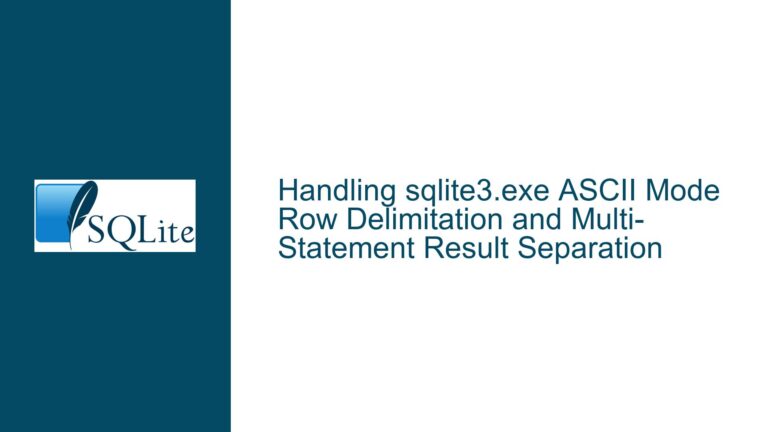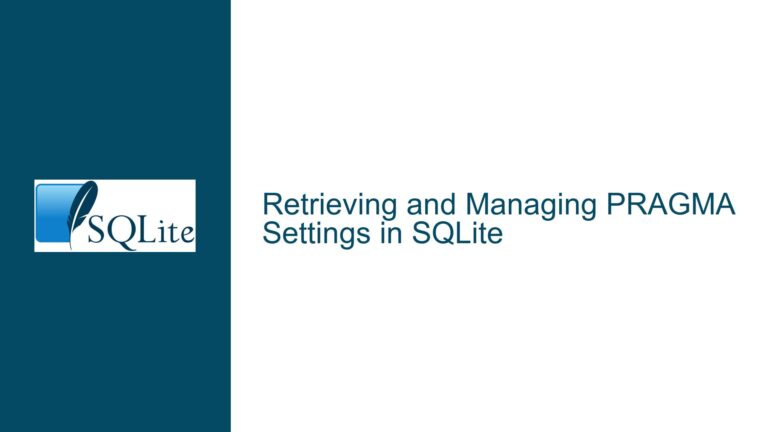Handling U+FEFF Character in SQLite WASM Wrapper Text Decoding
Issue Overview: U+FEFF Character Stripping in SQLite WASM Wrapper
The core issue revolves around the behavior of the SQLite WASM wrapper when decoding byte sequences into JavaScript strings. Specifically, the wrapper strips the leading U+FEFF character, also known as the Byte Order Mark (BOM), during the decoding process. This behavior is a result of the default configuration of the TextDecoder in JavaScript, which is set to ignore the BOM when decoding UTF-8 encoded text. The BOM is a Unicode character used to signal the endianness (byte order) of a text file or stream. However, in UTF-8, which is a byte-oriented encoding, the BOM is generally unnecessary and its use is discouraged.
The problem arises when the SQLite WASM wrapper is used to interact with a database that contains text values or column names that include the U+FEFF character. When these values are decoded into JavaScript strings, the BOM is stripped, leading to potential inconsistencies and unexpected behavior. For example, two distinct values in the database—one with a BOM and one without—could be decoded into the same string in JavaScript, causing issues with uniqueness constraints, grouping, and other operations that rely on string comparison.
The issue is further complicated by the fact that the SQLite C API, which the WASM wrapper is based on, does not strip the BOM. This creates an inconsistency between the behavior of the WASM wrapper and the C API, which could lead to confusion and bugs when porting code or comparing results between the two environments.
Possible Causes: TextDecoder Configuration and BOM Handling
The primary cause of this issue lies in the configuration of the TextDecoder used by the SQLite WASM wrapper. By default, the TextDecoder in JavaScript is configured to ignore the BOM when decoding UTF-8 text. This behavior is controlled by the ignoreBOM option, which is set to true by default. When the ignoreBOM option is enabled, the TextDecoder will strip any leading BOM characters from the decoded text, resulting in the observed behavior.
The decision to strip the BOM is rooted in the fact that UTF-8 is a byte-oriented encoding and does not require a BOM to determine byte order. In fact, the use of a BOM in UTF-8 is generally discouraged, as it can cause issues with legacy applications and is unnecessary for modern UTF-8 implementations. However, this decision can lead to problems when dealing with text that intentionally includes the BOM as part of its content, rather than as a metadata marker.
Another contributing factor is the difference in how the SQLite C API and the WASM wrapper handle text encoding. The C API does not perform any automatic BOM stripping, meaning that text values and column names that include the BOM are preserved as-is. This discrepancy between the two environments can lead to inconsistencies when the same database is accessed using both the C API and the WASM wrapper.
Troubleshooting Steps, Solutions & Fixes: Addressing BOM Stripping and Consistency Issues
To address the issue of BOM stripping in the SQLite WASM wrapper, several approaches can be considered. Each approach has its own trade-offs and implications, and the best solution will depend on the specific use case and requirements.
1. Modify the TextDecoder Configuration:
The most straightforward solution is to modify the configuration of the TextDecoder used by the SQLite WASM wrapper to retain the BOM during decoding. This can be achieved by setting the ignoreBOM option to false when initializing the TextDecoder. By doing so, the BOM will be preserved in the decoded text, ensuring that text values and column names that include the BOM are handled consistently with the SQLite C API.
However, this approach has several potential drawbacks. First, it may break existing applications that rely on the current behavior of the WASM wrapper. Changing the default behavior of the TextDecoder could lead to unexpected issues in applications that were not designed to handle BOM characters in their text data. Second, retaining the BOM in the decoded text could introduce new issues, particularly in applications that are not aware of the BOM or do not expect it to be present in their data.
2. Treat BOM-Containing Data as Blobs:
Another approach is to treat text values and column names that include the BOM as binary data (blobs) rather than strings. This would involve using the TextDecoder to decode the data into a Uint8Array or similar binary format, rather than a JavaScript string. By treating the data as a blob, the BOM would be preserved, and the data could be handled in a way that is consistent with the SQLite C API.
This approach has the advantage of preserving the BOM without altering the behavior of the TextDecoder for other text data. However, it also introduces additional complexity, as applications would need to handle binary data in addition to text data. This could make the code more difficult to maintain and increase the risk of errors, particularly in applications that are not designed to handle binary data.
3. Implement Custom Decoding Logic:
A more advanced solution is to implement custom decoding logic that handles BOM-containing text in a way that is consistent with the application’s requirements. This could involve using a combination of the TextDecoder and manual processing to detect and handle BOM characters in a way that preserves their presence or absence as needed.
For example, an application could use the TextDecoder to decode the text data into a JavaScript string, and then manually check for the presence of a BOM at the beginning of the string. If a BOM is detected, the application could take appropriate action, such as preserving the BOM or stripping it, depending on the specific requirements.
This approach offers the most flexibility, as it allows the application to handle BOM-containing text in a way that is tailored to its specific needs. However, it also requires the most effort to implement and maintain, and it may not be practical for all applications.
4. Update Documentation and Provide Guidance:
Regardless of the approach taken to address the issue, it is important to update the documentation for the SQLite WASM wrapper to clearly explain the behavior of the TextDecoder and the implications of BOM stripping. This will help developers understand the issue and make informed decisions about how to handle BOM-containing text in their applications.
In addition, providing guidance and best practices for handling BOM-containing text can help developers avoid common pitfalls and ensure that their applications behave consistently across different environments. This could include recommendations for when to use blobs instead of strings, how to detect and handle BOM characters, and how to test for consistency between the WASM wrapper and the C API.
5. Consider Backwards Compatibility:
Finally, any changes to the behavior of the SQLite WASM wrapper should be carefully considered in terms of their impact on backwards compatibility. Changing the default behavior of the TextDecoder could break existing applications that rely on the current behavior, particularly if those applications are not aware of the BOM or do not expect it to be present in their data.
To mitigate this risk, any changes to the behavior of the WASM wrapper should be accompanied by clear communication and guidance for developers. This could include providing a migration path for existing applications, offering tools or utilities to help detect and handle BOM-containing text, and ensuring that any changes are well-documented and easy to understand.
Conclusion:
The issue of BOM stripping in the SQLite WASM wrapper is a complex one that requires careful consideration of the trade-offs involved. While the current behavior of the TextDecoder is consistent with the general recommendation to avoid using BOMs in UTF-8 text, it can lead to inconsistencies and unexpected behavior in certain scenarios. By understanding the root causes of the issue and exploring potential solutions, developers can make informed decisions about how to handle BOM-containing text in their applications and ensure that their code behaves consistently across different environments.






